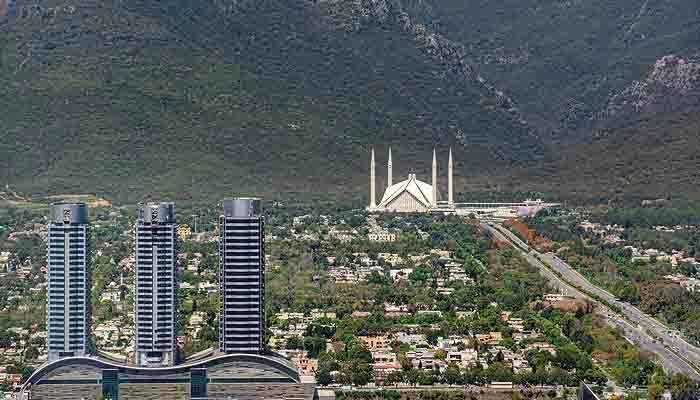Islamabad — from planned to unplanned city
Islamabad is fast becoming congested city where traffic jams are new normal
Islamabad is the only city of Pakistan which was established with a plan and vision as the national capital. Natural geography and beauty were key drivers for the selection of the area. It was decided that the natural beauty will be kept intact, and the ecosystem will be preserved. The sensitives of the ecosystem will be given due consideration and red lines will never be crossed. Thus, business and industrial elements were given less focus and included in plan as minor components in the design of the city. Only specific areas were dedicated for business and industry like blue area and I-9 sector, respectively. The location of the city, natural scenery, management, governance and care for nature it was dream city to live in.
Regrettably, the successive governments could not deliver on the promise and they started to undermine the original plan of the city. It is expanding without any plan or sense of planning. Housing societies have captured the surroundings of the city. Last two decades have witnessed a mushroom growth of housing societies at the name of decent living, engulfing huge land and natural resources. The ecosystem is being compromised by building ill planned hotels and restaurants in the national park and protected areas, which enhanced the vehicle movement in protected areas. It was accompanied by sporadic growth of small towns and unplanned settlements. We have seen many illegal Kachi Abadis and small towns in the surrounding of the city. Business groups also started to shift in Islamabad. It gave birth to the demand of professionals and labour. All these factors have led to massive migration of people, though the city was never designed for it.
Islamabad is fast becoming congested city. Traffic jams are new normal in the town. It is also putting pressure on the services infrastructure like water, health, roads and security etc. The government has to cut trees and disturb the natural landscape of the city to expand roads. Environment degradation is emerging as one of the biggest issues of the city. Smog has started to appear, which is entirely a new phenomenon.
Now the final nail in coffin is the creation of new economic centres in certain areas of the city. For example, the incumbent government have started to sell area opposite to the F-9 park as new commercial area and construction of work have been started. Concrete is taking the place of natural assets. The creation of new economic centers in Islamabad will lead to concentration of economic and livelihood opportunities. It is well established fact that economic opportunities act as pull factor for migration. Thus, it is expected that with completion of the projects, there will be a new influx of migrants to meet the needs of the new business.
The trend of urbanization in Pakistan also suggest the same. If we analyse the data of urbanization in Pakistan, concentration of livelihood opportunities emerged one of the key factors along with better service like education, skills and health etc. for unplanned expansion of cities. The new influx of people will further strain the housing sector and there would be a new chance for the land developers to go for expansion of their societies. Kachi Abadis will also expand as many low skill workers will also migrate to Islamabad.
The services sector will also come under pressure. As, we are already observing the initial sings of deficiency of services provision. For example, health facilities and hospitals are not able to meet the demand of population in the city. Same is true in the case of education facilities. Government is also spending good amount of resources to upgrade transportation infrastructure. However, it is feared, and it looks real now that soon city will cross the carrying capacity limit. Once Islamabad cross the carrying capacity limit, then the urban management solution will no longer be applicable.
Thus, there is need to act now and act wisely. The government can avert further deterioration by applying wisdom. City government can play a leading role, if they come out of twitter or social media management. They need to work on ground. We do not need to invent the solution; we can simply follow the teaching of our Prophet Hazrat Muhammad (PBUH).
He (PBUH) asked for creating new cities instead of expanding the existing cities. The word of wisdom has all economic and environmental sense and justification. As, we discussed above that economic, livelihoods opportunities and provision of services act as pull factors for the migration of people from rural to urban areas.
By concentrating economic and livelihood opportunities government cannot check the migration. Thus, to check migration and expansion of city, government will have to create new economic centers, which can provide decent livelihoods to people. It will also help to maintain good environment due to lower population density. It will not only help Islamabad but also other cities like Karachi, Lahore, Faisalabad, Peshawar etc.
Pakistan needs to develop new urban centers or adopt new concept of urbanization. Fortunately, Pakistan in the form of China-Pakistan Economic Corridor (CPEC) has an opportunity. CPEC provides Pakistan a chance to materialize this plan. Special Economic Zones and ML-1 railway can be used to build new cities and economic centers. Pakistan will only have to plan SEZs in such a way that it leads to creation of a new economic centres and cities or strengthen the existing small towns in far off areas. It is good to note that Pakistan is already planned few SEZs in such a way like Rashakia SEZ. However, there is need for create more SEZs.
Thus, Pakistan should work with China to look for new SEZs which can help create new economic centres especially in backward areas like, Southern Punjab, interior Sindh, Balochistan and the newly merged districts.
Historically it has been observed that transport infrastructure, especially the railway, especially in the surroundings of station, helped to create new economic centres and cities. We can apply this methodology to ML-1 project. It would be a win-win initiative. As, it will help in the success of ML-1, railway and creation of new economic centers.
Pakistan can also venture in a new concept of urbanization which follows the principles of sustainable development like Spatially Hybrid Urbanization Model. Pakistan needs to understand that to combat the challenge of the un-planned urbanization and expansion of cities beyond their capacity Pakistan will have to create new economic centers. If Pakistan fails to take necessary steps then nothing can stop the disasters, bad environment, bad quality environment and crimes in the cities and Islamabad will be no exception.
-
 'Kanye West Is Human Too'
'Kanye West Is Human Too' -
 Prince William Hands Kate Middleton Something Highly Sensitive To Manage With Coronation
Prince William Hands Kate Middleton Something Highly Sensitive To Manage With Coronation -
 Critics Get Honest About 'A Knight Of The Seven Kingdoms'
Critics Get Honest About 'A Knight Of The Seven Kingdoms' -
 Why Harry Unlikely To Meet William, Kate During UK Return?
Why Harry Unlikely To Meet William, Kate During UK Return? -
 X To Change AI Chatbot 'Grok' After Outrage Over Explicit Deepfake Images
X To Change AI Chatbot 'Grok' After Outrage Over Explicit Deepfake Images -
 Princess Eugenie Set To Hit New Milestone As Andrew's Eviction Looms
Princess Eugenie Set To Hit New Milestone As Andrew's Eviction Looms -
 Emilia Clarke Gets Honest About Featuring In Shows Like 'Game Of Thrones'
Emilia Clarke Gets Honest About Featuring In Shows Like 'Game Of Thrones' -
 Amazon Employees’ Break-time Fight Ends In Murder In Texas
Amazon Employees’ Break-time Fight Ends In Murder In Texas -
 Peter Jackson Reveals A Viggo Mortensen Mishap In 'LOTR' Fans Totally Missed
Peter Jackson Reveals A Viggo Mortensen Mishap In 'LOTR' Fans Totally Missed -
 Marsh Farm: Work Underway On Andrew Mountbatten-Windsor's New Home
Marsh Farm: Work Underway On Andrew Mountbatten-Windsor's New Home -
 'Rip' Director Dishes On Matt Damon, Ben Affleck's ‘brotherly’ Dynamic
'Rip' Director Dishes On Matt Damon, Ben Affleck's ‘brotherly’ Dynamic -
 Meghan Markle Handed Strict Warning: ‘You’re Playing With Fire In A High Risk, High Noise’ Game’
Meghan Markle Handed Strict Warning: ‘You’re Playing With Fire In A High Risk, High Noise’ Game’ -
 Kate Middleton’s Secret Message Decoded: ‘She’s Done With All This!’
Kate Middleton’s Secret Message Decoded: ‘She’s Done With All This!’ -
 Paul McCartney Reveals How Close He Came To Giving Up Music
Paul McCartney Reveals How Close He Came To Giving Up Music -
 Police Uncover Secret Cannabis Empire Ran By New York Woman
Police Uncover Secret Cannabis Empire Ran By New York Woman -
 'Euphoria' Season Three Trailer Shows Chaotic Life After High School
'Euphoria' Season Three Trailer Shows Chaotic Life After High School




